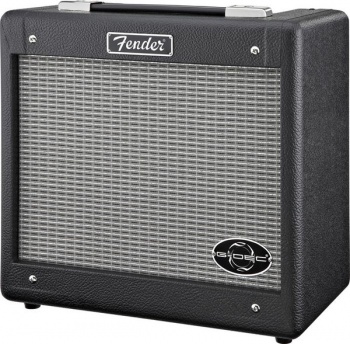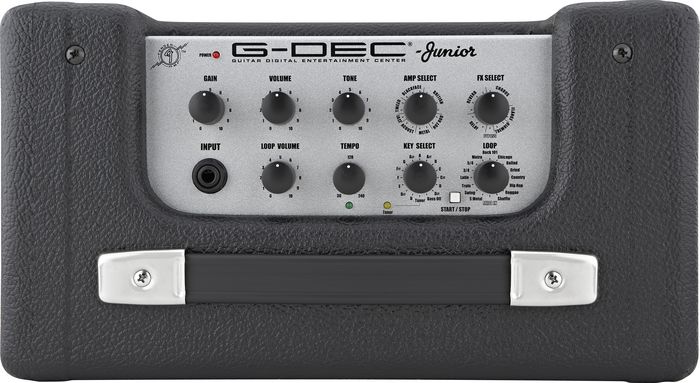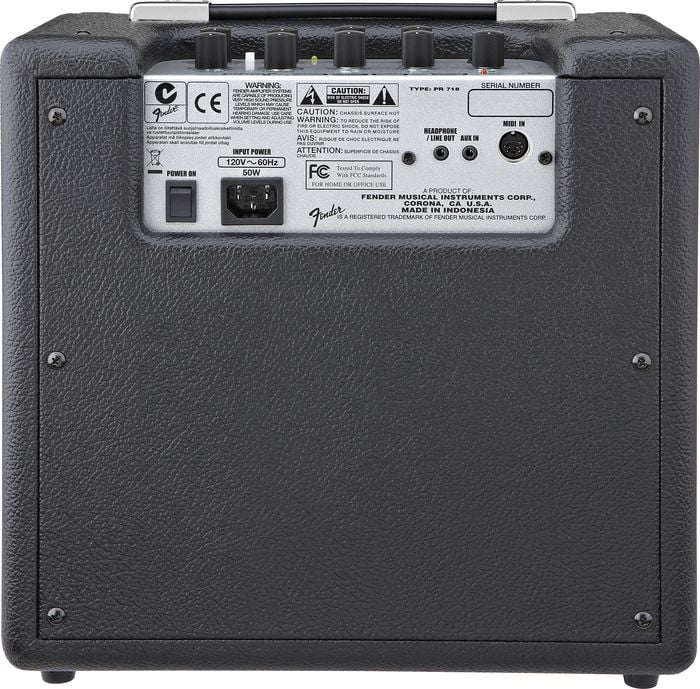G-DEC JUNIOR
| Line 1: | Line 1: | ||
[[Category:Gear]] | [[Category:Gear]] | ||
| - | [[Image:gdecjr.jpg|thumb|350px| | + | [[Image:gdecjr.jpg|thumb|350px|right|G-DEC JR]] |
== General Information == | == General Information == | ||
Current revision
Contents |
General Information
Weapon: Solid State Guitar Amp
Make: Fender
Model: G-DEC JR
Price: Around 200$/180€ (Online shops a bit cheaper. As usual.)
Sound
G-DEc JR belongs to the G-DEC family of Fender Amps, and the "DEC" part of the name actually stands for Digital Enterteinment Center. And that's a pretty accurate definition of this amp, because it's made to have fun learning from front to back!. But let's see why... Keep reading!
This amp is part of the new generation of all-in-one modeling + effects line that most companies are getting on the market since a few years ago. Before we go deep into the old discussion of quality of digital stuff vs the good old tubes and analog stomps, maybe we should stop and actually look at this cheap amp as what it is: A versatile tool for the beginner to learn with no real aspirations beyond that. 15 Watts in a 8 inch cone are just enough for some bedroom riffing after all.
And it does pretty well at this task: It includes lots of knobs for the guitar newcomer to tweak and search for the sound of his favourite band. And that's good, given it's price tag. Let's see what this amp hides under its belt:
- 15 Watts into an 8" Special Design Speaker.
- 16 Amp Types
- 15 Special Effects Presets, Including Reverb, Delay, Chorus, Flange and Tremolo.
- 15 Drum/Bass/Accompaniment Loops
- Metronome.
- Key Selector Knob Allows for 14 Different Keys
- Tempo Knob Allows Settings from 30 to 240 Beats Per Minute.
- Separate Controls for Guitar Volume and Backing Loop Volume.
- Built-in E-tuner with LED Indicator.
- MIDI Connector Allows for Streaming Files from Computer.
- 1/8" AUX In Allows Jam-along Capability with External CD or MP3 Player.
- 1/8" Headphone Jack Doubles as a Line Output to Recording Gear or Other Amplifier
Now, how is that for a start? Not bad. But let's discuss how it actually performs.
The main control panel looks like this:
Being this a Fender amp, no one will be surprised to hear that it's clean amp settings sound really good. Even though it's cheap, it still gets that twangy sound that sounds warm even though it has a solid-state heart. Bare in mind that you just can't compare this to a Fender Twin reverb, they are not even in the same neighbourhood, so understand that this amp has a great clean sound in it's price range.
The same is just not true when it comes to the high gain channels. The do their job, but they miss some punch. Again that is to be spected from cheap solid state amps with a small cone (8), so no big surprise in that department. Still they don't sound bad, but they sure won't shake the house like, let's say, a cheap Roland would.
How about the effects? They are OK, but nowhere near as good as separate stomp boxes or a good multi-effect unit would provide. Nevertheles they sound good enough to provide a nice touch to the variety of sounds you can get from the amp, and allow to get quite close to whatever sound you are after. No auto-wah effect though. The effects are of course very limited in their depth and tweaking, they pretty much come pre-design, and that's it. Good reverb though, probably the best effect of all, along with delay wich comes in 3 pre-defined settings (130-300-500 ms).
But why do they call this a Digital Enterteinment Center? So far it's just an amp with some effects. Oh wait. there's more to it, let's talk about the backing loops!. Yes, this amp has an extra little treasure within it's guts, and that's quite a few pre-recorded loops in different styles, to jam along with. They all can be set to play at different speeds, and in 14 different keys. That's just wonderful for a guitar beginner to practice some pentatonic boxes in different keys and even increase the tempo as needed.
The bass can be muted so that only the drums play, so the loops act as a limeted drum machine, which comes handy when you want to practice to a beat and get bored of the metronome. Did I mention that it also has a built-in metronome?
One of the best features of this amp is that it has separate volume controls for the backing and the guitar input, allowing you to choose wether you want a light band backing or a really heavy drummer behind you depending on the occasion.
One of the things that should be improved in this amp is the EQ controls though. It has only one Tone control, and that's it, no lows/mids/highs separate knobs. A shame, but at least the one tone knob provided is pretty responsive.
Connections
How about the connections? Let's take a look:
As you can see in the picture the amp has a line out/headphones mini-jack out in the back, good to plug the amp into a computer or play silently when the loved ones are sleeping in the room next door.
It also has a nice line in mini jack input to plaug in your CD/mp3 and jam along with your favourite bands/backings. Expected in a practice amp.
Last input is a MIDI connector, that comes in handy when in need of streaming some samples from your laptop.
All of them are pretty much standard connections for a home use little practice amp, so no surprises or big let downs in this department.
Detailed Specs
Controls: Gain, Volume, Tone, Amp Type, Effects Select
Backings: Volume, Tempo, Key, Loop Select, Start/Stop
Weight 15 lbs. (6.8 kg)
Dimensions:
Height: 12.5" (31.5 cm)
Width: 13.25" (33.6 cm)
Depth: 7.25" (18.4 cm)
Covering: Black Textured Vinyl with Silver Grille Cloth
Loop Select:
Rock 101
Chicago Blues
Ballad
Grind
Country
Hip Hop
Reggae
Shuffle
MIDI IN
Speed Metal
Swing
Train
Latin
Waltz
5 on 4
Metronome
Effects
Chorus 1
Chorus 2
Chorus + Delay
Chorus + Reverb
Flange 1
Flange 2
Tremolo 1
Tremolo 2
Delay 130 ms
Delay 300 ms
Delay 500 ms
Plate Reverb
Hall Reverb
Spring Reverb
Reverb + Delay
Bypass
Amp Models
British (Four kind with different gains)
Hot Rod (2 kinds high gain)
Metal (2 kinds, one darker)
Acoustic (2 Kinds, Rythm and fingerstyle)
Jazz
Tweed (Clean and crunch)
Blackface (3 Kinds ranging from clean to crunch)
Feel
This amp is easy to use with all its separate knobs, one for each function. Practicing some GMC lesson and finding a similar sound out of this amp only takes a couple minutes. Of course the tone you get is just similar, but that's enough for a beginner to practice and have some fun.
No use taking this baby to a gig, it just won't deliver. 15 Watts solid state is not loud enough to play along with a drummer, and the sound quality at high volumes is not good enough. This is a practice amp, and should be used as that.
Seems sturdy enough to take some blows, and the size is just good enough to take it with you if you have to travel often.
Cons
- Small cone (8 inches)
- Just one Tone knob.
- No auto-Wah effect
- Effects not very tweakable
- Poor high gain sounds
Of all those the absence of real EQ settings is probably the biggest flaw, which can be overcome using an external EQ stomp box or a multi-FX device with EQ controls. Too bad they didn't add that couple extra knobs.
Overall Impression
Good enough for beginners and that's pretty much it. Does it's job pretty well though, being versatile and providing an excellent base to understanding basic effects and most common types of amps. Nice cleans, nice reverb, above average for blues in it's price range, and a little bit below average in it's high gain settings. Nice clean model amps to use with stomp boxes though.
Basic tweakable backing tracks help beginners to jam along, either with a band or just drums or metronome.
This amp is made to have fun, and it sure provides some nice tools to achieve your goals.
Alternative Weapon
There are many other alternatives out there, such as the Roland Cube series, which come packed with really nice effects and amp models, but lack the backing loops.
Line 6 also manufactures some nice modeling amps worth checking out, as well as Vox. Better take a walk down to your local shop and give them all a try, after all every amp tone is different, and you will need to listen to them yourself.
Originally by Fran








